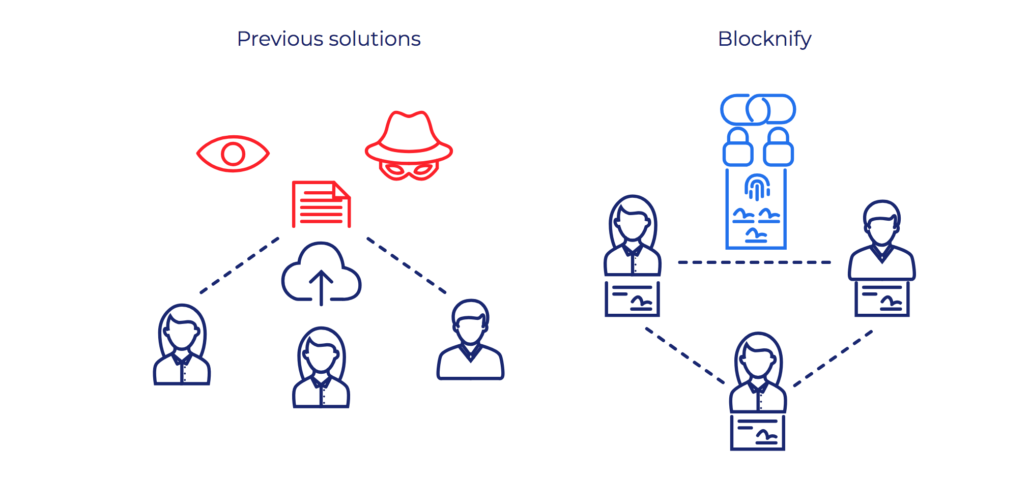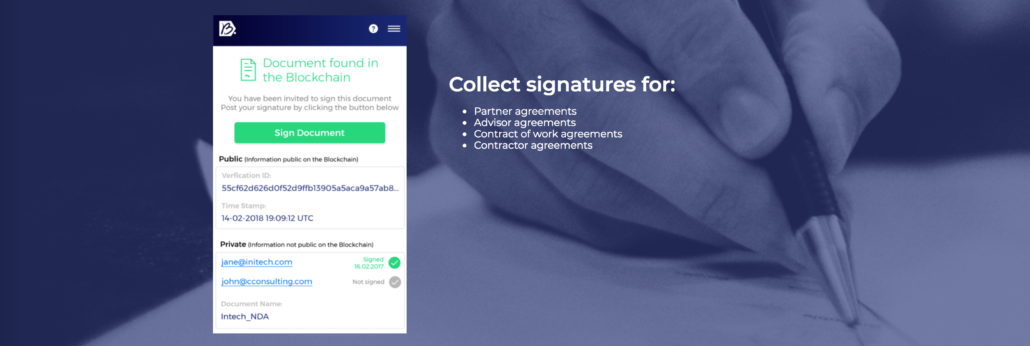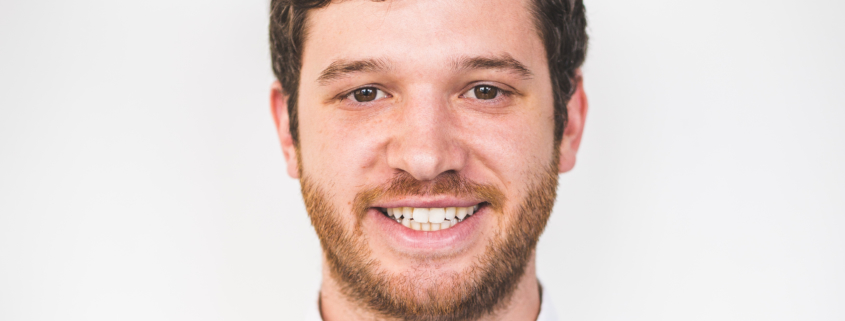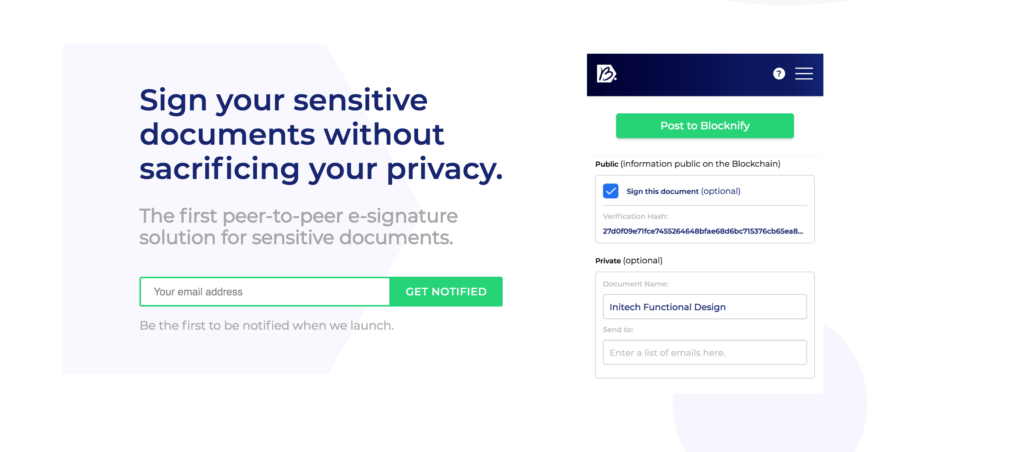Meet Blocknify: E-Signatures Without the Cloud
Blocknify, one of the 6 Batch 9 startups at StartupYard, actually began life at StartupYard, long before now CEO and Co-founder Chris Cowles came onboard. It was originally the brainchild of StartupYard alum Dite Gashi, and a team of developers from Budgetbakers he worked with at the KB Hackathon, cohosted by StartupYard last year.
Though the initial pitch for Blocknify was not much more than a QR code connected with the Ethereum blockchain to verify the authenticity of contracts, the idea clicked, and StartupYard along with Decissio started looking for a real Founder/CEO for the project. We found him this year, and since he arrived, he’s made Blocknify his own. I sat down this week with Chris Cowles to talk about Blocknify, and how he came from working for Amazon in Seattle, to running his own company in Prague.
Hi Chris, you joined StartupYard after meeting one of our alumni, Decissio. How did you end up taking charge of Blocknify?
That’s a classic Prague story! It started before I came here actually. StartupYard investor Philip Staehlin sort of came up with the idea when he was having issues signing sensitive documents with a big group of people.
A bank VP told Philip stories of how he had signed confidential documents in the past. They used to take the multiple copies of the contract and tape them up to the windows of a conference room. That way, they could compare the multiple copies and ensure that they were identical and there were no differences, just based on the line-endings and paragraph sizes.
Obviously that’s crazy in this technological age, but it still happens. Anyway, Phillip shared that idea with Dite Gashi, who is a StartupYard Alum (Decissio), and Dite worked on it with a few friends from BudgetBakers (another SY alum), at a KB hackathon organized by StartupYard. The idea the team came up with to verify contracts was to attach QR codes, and allow people to basically scan the contract with a smartphone and confirm there haven’t been any changes. It would use the Ethereum blockchain to make it transparent and also secure, because none of the data in the contract needed to be shared in order to verify that a new copy is authentic.


Chris, Dite, and the Blocknify team
The team did really well at the KB hackathon, but they were all working on other projects, so the idea didn’t really have an owner. Since Startupyard was interested in the idea, you guys encouraged Dite to find someone (eventually me), to take it over and become CEO for the project. I had just moved here from Seattle, and was looking to get into blockchain development somehow. I found the project by chance on LinkedIn. I actually read Dite’s interview on this very blog, which convinced me I had to check out the project and StartupYard. It just clicked for me.
A few months later here I was, attending startupyard as CEO of Blocknify. We have a development team in Kosovo thanks to Dite, and we’ve simplified and clarified the original idea to something really amazing. I’m excited to talk about it.
Blocknify aims to allow professionals to safely and securely sign documents anywhere, without ever hosting them on cloud servers. How does this technology work, and why is it so different from competing solutons like DocuSign?
Contracts are inherently sensitive. Of course you might not worry too much if certain documents were intercepted or stored improperly, because usually a contract by itself isn’t very compromising (unless you are Donald Trump). However, for businesses as well as for individuals, the sum of all your contracts is kind of the blueprint to your business or your life. It’s a roadmap to your strategy that, if someone had access to all of it, they could gain a serious advantage over you.
As we know from recent experience, centralized databases are prone to theft and hacking. It is innevitable as long as the incentives are there to misuse that data.
Despite this known issue, Europe is not adapting quickly to e-signatures, with many corporations having policies against the use of any software for contracts. Of course it doesn’t help that the regulatory system in Europe is very complex, which is a big part of the challenge of driving adoption of e-signatures.
What is particularly good about Blocknify is that it gets past many of these barriers by not acting like a cloud service. We do not need to store contracts in any reconstructible way, and no part of anyone’s sensitive data needs to touch a server.
Yet we are still able to ensure for multiple parties in different places that the contracts they are signing are the same. That’s because when any user has the contract in front of them on their computer and signs it, that signature is irrevocably recorded in the Ethereum blockchain, and it is attached only to that exact version of the contract. Because we use a unique fingerprint of the document to apply signatures, if someone were to change the document in any way, the unique ID would be different therefore the signature would not match.
In essence what Blocknify allows companies and individuals to do is have the same level of security and verification as if all the signatories were sitting and signing the same exact piece of paper. No chance to hide anything or make unauthorized changes. All documents stay local, without touching the cloud, just like with paper.
Your solution uses the Ethereum blockchain. Many people aren’t deeply familiar with how that works, and what the advantages of distributed ledgers are. Why is Ethereum so important for your solution?
The most important thing to know about why we use the Ethereum blockchain is that in order for Blocknify to work, signatures must be totally immutable. There is just no reason to sign something if someone can modify or destroy the signature later. That’s like signing a contract and then not keeping a copy with the countersignatures. Ethereum is a distributed database of all those countersignatures that can’t be changed, only added to.

On Blocknify, once you sign something, it’s signed. That version of the document is signed, but no other version. The thing about databases in the traditional sense, like a cloud storage platform or an on-premise server, is that it is taking something inherently mutable and making it immutable using software. The problem is that the more functionalities and permissions you add on top of a database, the more possibilities there are for a security flaw, and thus for data to be corrupted or changed. A database can be built very secure, but it is mutable by nature.
Blockchain doesn’t have to be like that. Because it is distributed across many, many nodes, no attacker can change the history of transactions without the permission and agreement of a majority of the nodes. As long as there are many actors in the system, the vulnerabilities in any one particular node are minimized by the whole. Ethereum is designed to be very inflexible: it does not focus on speed and ease of use, but on absolute certainty that a change to it is legitimate. Then on top of that, we can build an application layer that is easy to use, like Blocknify.
The great thing about that is that as long as the Ethereum blockchain is used, the records it creates cannot be destroyed or altered. It is safe from disaster in a way. You can’t lose the records in a fire, like you could with paper. You can’t misplace them. If they are destroyed locally, you can still get them back.
So if you imagine a world where all contracts are smart contracts on blockchain, and some disaster happens like a Tsunami, and wipes out all the local databases of a particular company, then every one of their agreements and contracts could still be recovered from their counterparties, and would also still be in effect.
All that being said, as our customer, you don’t need to think about the blockchain or know how Ethereum even works. It is just a way of having a database that is fully transparent and safe in the way it stores and collects data. The way our technology works, we have no access to data from our customers, so no one else does either. Unlike any other e-signature service, there is no risk of a data breach with us because we don’t have any of your data.
This is not only secure in a way that cloud platforms aren’t, but it also makes auditing and verification of authenticity much easier. Because there is no centralized database that can be corrupted, there is also no way to fake, undo, or override previous changes. Anything signed is signed, and the only possible way the signature data is useful is if you have the document it relates to.
To you, what does the future of contracts and signed agreements look like 5 years from now? How will most people be signing and handling confidential documents?
It’s too obvious to say that contracts and the signing process will be paperless. There will be die-hard businesses that still use paper, but changes in regulations such as GDPR will also accelerate the need for everything to be digital, auditable, and in the control of the owners of the data.
I am not going to predict with certainty that you will be using the blockchain to sign everything. You might. Either way, laws and regulations will be focused more on immutable workflows, one way or another. We will have an ever increasing need for systems and databases that cannot be faked, back-dated, or overwritten without some sort of trail. As all things go digital, the danger is the same as with paper: you can destroy documentation and you can create false documentation.
In analogue technology, there have always been ways of using one-of-a-kind aspects of documents to make them resistant to fakery. Watermarks, stamps, holograms, even the grain of paper. The Romans used wood chips that could be matched to each other to verify agreements, for example. They could cut the woodchip in half and only the two pieces matched each other because the wood grains were unique and impossible to fake.
The blockchain replicates that effect. It’s like the blockchain is half of the woodchip, and a private key is the other half. Both unchangeable, both permanent, both only working with the other. That kind of inherent incorruptibility is going to be vital for making digital agreements work in the future.
Of course, blockchain technology also means that we can go beyond the analogue functionalities of a wood chip or a notarized signature. We can construct smart contracts that will only execute when other contracts and agreements have already been fulfilled on the blockchain.
For example, suppose you want to do factoring of your invoices, which means borrowing money against money owed to you as a company, which is a common process in business. Today in order to do factoring, the bank or lender loaning you the money must trust your clients and their agreements with you. If those clients don’t pay, it is your company that is responsible for that. In addition, the lender has to trust that you will pay them back when you get the income you’ve invoiced for.
With a smart contract, you could create a factoring system where that is all automatic. The lender can see the status of the contracts, and can be paid directly from the source. In addition, a smart contract can even put safeguards in place so that a lender knows that the companies which owe money will be able to pay the invoices when they are due. This would also give a lender a way to very safely lend the money, and a company that needs factoring of its invoices a very easy way to get liquidity when it is needed.
In fact, we have built a system just like this for a major bank already. I can’t share more details yet, but this is a really exciting possibility for banks, and for their client companies that face liquidity issues. I believe that solutions like the one we are providing will be the standard in a few years.
What is your go-to-market strategy today, who are you targeting, and where do you see that leading in the next few years?
We were lucky to find our first paid customer early on (Raiffeisenbank) and were able to deliver an API version within a month. Our main go-to-market strategy is B2B as this is business productivity software. Still, because organizations require more significant features, we realize that Blocknify can bring value in a simpler form. With that understanding, we decided first to produce a version meant for freelancers, contractors, and small businesses. We will be launching this version within this quarter (Q2 2018). Then we plan to release an enterprise version in late Q3 2018.

Today our platform allows us to build processes into our smart contracts. For example, you have a contract but it is only valid for a certain amount of time. If the contract is self-executing, there’s no need to actively monitor it. Also, we can do something similar for approval processes, and we see these self-executing smart contracts involving more processes over time. We believe this change will happen and we want to provide simple solutions to help companies realize the benefits of smart contracts.
You joined StartupYard in March. What did you expect from the experience, and how has that compared to reality? What has been your biggest challenge in the program?
Coming from consulting, I knew the value of getting an outside opinion for creative inspiration or challenging assumptions. I was expecting StartupYard with the mentors to be the outside consultant to challenge and inspire new ideas. This did happen, and we have benefited greatly from this.
What I didn’t expect was to find partners to help us avoid the common pitfalls, but also going beyond that and helping us grow a business that is self-sustaining and with a strong long term vision. From the outside the acceleration process looks like a carwash, but from the inside, you’re rebuilding the whole engine. When you’re starting a startup, you don’t know how to match your vision with what’s real. At StartupYard you integrate the vision and reality and make it real.
I believe you’re the first American to join the accelerator as a founder. Tell us a bit about your history, and how you ended up in Prague. What was surprising, either pleasant or not, about the transition?
Actually I am Czech on my Mom’s side of the family, but going back to her grandparents. She grew up in a Czech neighborhood in Chicago, with church services in Czech and Slovak. She taught me a lot about the Czech culture, and it ended up being a hobby for me. I used Czechoslovakia and Czechia as topics for a lot of school projects, and things like that.
I started out my career in Seattle, have traveled and lived in South East Asia as a management consultant, eventually living in Seattle again and working for Amazon. I didn’t really want to stay there, and I wanted to run my own company. That’s also a family thing, because my dad also founded and sold his own startup in the past. So I booked a ticket to Europe just to sort of look around. I ended up in Prague, and instantly fell in love. And of course, while I was visiting I met a girl as well. So I was hooked, as many people have been before.
To me Prague is the perfect size for what I want to do. It’s not in the spotlight like San Francisco or London, but it’s smart, there’s lots of local talent, and it still retains this unique atmosphere that my Mom loved about her “Bohemian” neighborhood in Chicago.





